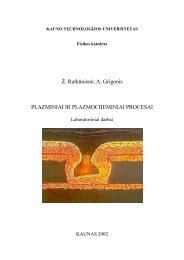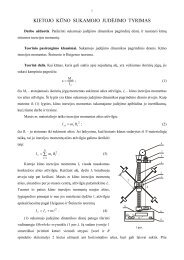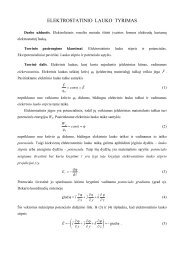PROCEEDINGS OF THE 7 INTERNATIONAL ... - Fizika
PROCEEDINGS OF THE 7 INTERNATIONAL ... - Fizika
PROCEEDINGS OF THE 7 INTERNATIONAL ... - Fizika
Create successful ePaper yourself
Turn your PDF publications into a flip-book with our unique Google optimized e-Paper software.
M. Pučetaitė et al. / Medical Physics in the Baltic States 7 (2009) 96 - 99<br />
monohydrate to 1324 cm -1 for calcium oxalate<br />
dihydrate (Fig. 3).<br />
The second issue in this study is related to distribution<br />
of chemical components in the cross-section of the<br />
stone. FTIR microscope was used for capturing of<br />
infrared image of cross-sectioned stones. The spectra<br />
from small areas of the cross section (100×100µm)<br />
were used for constructing false-colour images.<br />
Optical density<br />
Wavenumber, cm -1<br />
600 800 1000 1200 1400 1600 1800 2000<br />
Fig. 1. Spectrum of pure uric acid stone (top) compared with<br />
spectrum of uric acid from the library (bottom).<br />
Optical density<br />
600 800 1000 1200 1400 1600 1800 2000<br />
Wavenumber cm<br />
Fig. 2. Spectrum of urinary stone (top) constituted from<br />
calcium oxalate (black curve), carbapatite (blue<br />
curve) and struvite (red curve).<br />
-1<br />
Optical density<br />
Optical density<br />
Wavenumber, cm -1 Wavenumber, cm -1<br />
600 1000 1400 1800 1200 1300 1400 1500<br />
Fig. 3. Spectra of stones containing calcium oxalate monohydrate<br />
(bottom) and calcium oxalate dihydrate (top). The band of<br />
the latter is shifted to the side of higher wavenumbers.<br />
The images were obtained by integrating area under<br />
specific spectral band. Having analyzed the data<br />
obtained, we divided the stones into two groups: the<br />
ones with some ordered distribution of chemical<br />
components and the others without any organized<br />
structure. One of the stones constituted of calcium<br />
oxalate and calcium phosphate (brushite) is shown in<br />
figure 4. Optical and false-colour images of this stone<br />
97<br />
are presented in figure 6. The false-colour image in the<br />
middle shows how calcium oxalate is distributed in the<br />
cross-section of the stone. Red colour corresponds the<br />
areas where the concentration of calcium oxalate is<br />
high and blue colour – where the concentration is low.<br />
The bottom image represents distribution of brushite.<br />
Having these images in mind, we can assume that the<br />
stone was induced by small deposit of brushite on the<br />
epithelium and the layer of calcium oxalate formed on<br />
it through time.<br />
Fig. 4. A photo of the stone constituted from calcium<br />
oxalate and calcium phosphate (brushite).<br />
A photo of another stone, constituted from calcium<br />
oxalate and calcium phosphate (carbapatite), is<br />
presented in figure 5. False-colour and optical images<br />
of this stone are shown in figure 6. Here we cannot see<br />
an organized structure, and the chemical compounds<br />
are distributed randomly in the cross-section of the<br />
stone.<br />
Fig. 5. A photo of the stone constituted of calcium<br />
oxalate and calcium phosphate (carbapatite).<br />
From this data, we can assume that both chemical<br />
components are distributed in the stone evenly what is<br />
resulted by simultaneous crystallization. In addition,<br />
there is no evidence that the stone formed on<br />
epithelium before it became loose. Most likely, the<br />
stone formed from oversaturated solution of the<br />
compounds.








